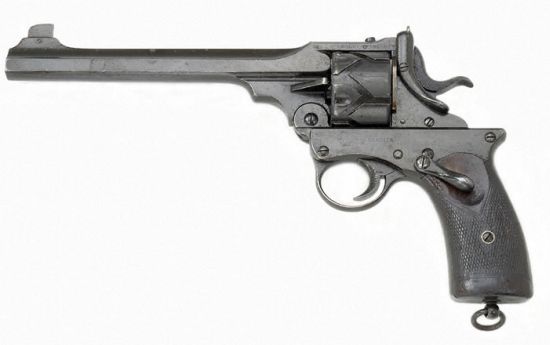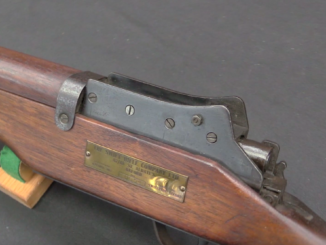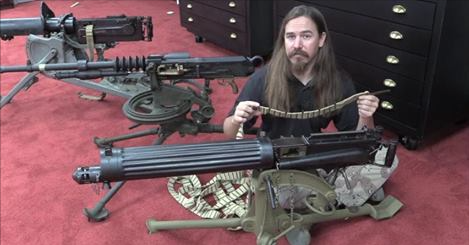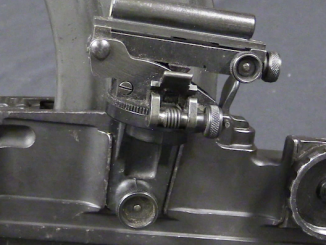I recently got an email from Jonathan Ferguson at the British National Firearms Centre (better known as the Pattern Room) asking if I might have any first-hand written accounts of the Webley-Fosbery being used in combat during World War I. It’s well known that a bunch of these automatic revolvers were purchased by British officers, but there seems to be a total vacuum of primary source material on how they performed. It’s easy to find authors saying they were poorly adapted for trench warfare (which seems to be a safe assumption), but no reference to anyone who actually carried one of them saying so.

I double checked through all of the Fosbery reference material I have, and sure enough, not a single first-hand word about their field performance. So I figured I’d ask you folks – does anyone have any first-hand account of a Webley-Fosbery’s performance in military service?




There are few floating around in India. Some families still have them from their service days. It was very common and there even copies of this gun.
I’m not sure the Semi-auto Webley was in India, but the standard normal ones, I know the IOF still produces a .38 S&W Webley.
There is also a .32 S&W Long version of the Webley made by OIF that is more-or-less civilian legal (apparently Indian gun laws make Boston look like Houston) as well as a Lee-Enfield chambered in rather odd 8mm cartridge that was designed by a committee that knew nothing about ballistics. I was curious enough to do some checking and apparently neither are exported; I couldn’t find any record of even samples in the US.
Semi-related… there is also a Royal Enfield motorcycle factory left over from the colonial days that makes 350cc and 500cc singles that look exactly like they rolled off a factory floor in 1950. I met a guy who has one (a 350 diesel, of all things) and it is a beautiful bike but it is a little quirky. If you ever owned a 1970s British bike (I did) just think “Lucas of India.” The Lord of Darkness meets Shiva the Destroyer.
I don’t think the Austro-Hungarian military committee was that misinformed.
The info that I saw indicated that it was a post-indepdence locally-designed 8mm cartridge that was unrelated to anything made by Mauser or Mannlicher. I assume this is one of those no-military-chamberings-for-civilians thing. Never even saw a picture of the cartridge, but I read something scathing about the ballistics and bullet design. I was really more interested in the .32 Webley (I’ve owned a .32 J-frame Smith that was a really fun plinker/ farm carry gun) and the info on the Lee-Enfield came up while I was going through what little info I could find on OIF and looking to see if their products had been imported on a limited scale the way the Enfield motorcycles (which have been imported since the 70s and I’ve only seen a couple of them) are.
“Lee-Enfield chambered in rather odd 8mm cartridge that was designed by a committee that knew nothing about ballistics.”
Did the IOF .315 Sporting rifles
http://en.wikipedia.org/wiki/IOF_.315_Sporting_Rifle
matches your requirements?
Above-mentioned link stated that this rifle uses cartridge derived from 8x50mm Mannlicher but with hunting bullets.
IIRC, IOF also gets away with charging outrageous prices because they’ve got a monopoly on sale of firearms to civilians.
Jim, I have to admit that your reminiscences brought back a good many memories about vintage motorcycles, as off-topic as they might be in the context of this forum. I dearly loved your last-sentence comments about “Lucas Of India” — how very true! I distinctly remember how we sardonically used to refer ( quite accurately, as it turned out ) to the lighting output of traditional British motorcycle headlamps as being part and parcel of “Lucas’ glow worms” — a somewhat sarcastic alliteration to the less-than-satisfactory output of Lucas magnetos and alternators! Of course, modern motorcycle technology is literally infinite light years removed from this state of affairs in every imaginable area ( as it should be ), but I can’t help but feel some nostalgia for the old days in spite of everything.
I love your metaphors! I also had a soft spot for old British bikes! A old army BSA from before the war in Ethiopia and a BSA 450 single “café racer” in Germany. That was also where I was cured of that ailment by a 500 CC two stroke triple Kawasaki that would rip the side covers off of any British bike extant in 1969 as it blew by.
Now onto first hand accounts of Webley Automatic Revolvers. I was in Israel on business when a couple of bad guys showed up to shoot up the local Coffee Shoppe, but before I could deploy my side arm, a local girl who could not have been more than 14-15 years old who was sitting just behind and to my side had retrieved her Webley Zig-zag revolver out of her gigantic purse/bag and shot each of them with one round in the head with her .455! She then replaced the weapon in her purse and continued to drink her coffee and chat with friends until the cops showed up. I asked why she did not reload before putting her weapon away and she told me she did not have any more bullets than were in the gun! She produced her documents and then went on her way.
It was most embarrassing for me as I had by that time spent almost ten years in the middle east and was well aware of the LIPs predilection to violence, while using a pistol as my primary defensive weapon and had ten years with much experience before, where my primary offensive weapon was also a hand gun. I was there to train some folks in the use of hand guns as thier “Primary Offensive Weapons”!
Oh the dark prince of electrics! who the hell thought pushing current backwards was a good idea? (proud owner of a Norton)
BTW, if we discuss the Webley-Fosbery. Did the .38 version is design to fire original .38 Auto (130-grain @ 1260fps from Colt Model 1900) or later .38 Auto with lighter powder charge?
On my desk in front of me right now is a yellow-and-red box of 25 rounds of Kynoch brand “.38″ Automatic Pistol Cartridges, Smokeless Powder, Metal Covered Solid Bullet 130 Grns.”, as it says on the top of the carton.
On the side it says “.38″ AUTOMATIC ADAPTED TO Webley & Scott and Colt Pistols”.
Webley did make automatic pistols for the .38 ACP cartridge (Models 1910 and 1913), but of course the Webley-Fosbery was also chambered for the .38 ACP round.
My SWAG would be that whatever the .38 load available in the 1909-14 timeframe was, that would be the one that was used.
BTW, the other end of the box says the cartridges are fitted with “non-rusting caps”, i.e. non-corrosive priming. And on the bottom it says “Manufactured at the Kynoch Factories of Imperial Chemical Industries Limited, Metals Division, Witton, Birmingham, England”.
Below that is the ICI logo, and below that is a large rubber-stamped “30 R H”. Two other such boxes I have are stamped “16 R I”. They have a small “83” printed at the very bottom, while the “30 R H” box has a small “KK” printed in roughly the same place.
I’m including all this because it might help date this ammunition, by lot, and thereby give some clues as to loading, etc.
Hope it helps.
cheers
eon
According to Fred Barn’s “Cartridges of the World” The original loading of the .38 Colt Automatic Pistol ammo was a 130 Grain bullet at 1,000 FPS.
When the Germans wanted more “Knock down” than the .30 Luger and 7.62X25 Mauser could provide they tested the 9 MM Luger prototype ammo and found that a stiff compressed charge of double base, fast burning powder would propel a 124 grain bullet at 1,150 FPS and knowing that the original Colt load was not as good, made their mind up, and the rest is history.
Note that current 9 MM NATO load is 395 M/S, or 1295 FPS out of a 4″ BBL with the same bullet and it still is considered to be the “week kneed sister” of the .45 ACP a load with considerably less power???
(scrolls through comments looking for combat use stories)
Nope. No first hand accounts.
Might I suggest that those who tried to use these in combat didn’t survive the attempt?
Entirely possible. Check out the 1973 John Boorman SF film “Zardoz” starring Sean Connery. Connery used a .455 Webley-Fosbery in it, and due to the blank loads not developing enough recoil to operate its action, he had to rack the barrel/cylinder assembly by hand for every shot.
Simply recocking the hammer of the single-action revolver would do no good, as the hammer did not rotate the cylinder with a lifter; rotation was by a stud in the fixed lower frame engaging z-slots in the cylinder rather like the Mauser “Zig-Zag” revolver of the 1870s. Simply thumb-cocking the hammer would result in it falling on the same cartridge again. It might set off a “dud” with a hard primer; then again it might not.
Now imagine this happening to a British officer in Flanders during a night trench raid. If he were trained on the Webley MK VI .455 double-action revolver, it’s very likely that under stress, he would try to bypass a “dud” by simply pulling the trigger again by reflex, which on a DA revolver immediately results in the hammer falling on the next round up.
With the Fosbery, it more likely resulted in him being shot by a German soldier before he realized he was using the wrong IA procedure for that particular revolver.
Even racking the action by hand as Connery did was an awkward maneuver, especially in the dark. Again, there’s a good chance of being shot by the enemy while trying to remedy the situation.
The Webley MK VI was hands down a much better fighting revolver than the Webley-Fosbery, no matter how good the latter was for bulls-eye shooting on a nice, peaceful target range.
cheers
eon
Look up!
My account is absolutely “First Hand” I was less than five feet from the shooter and less than fifty feet from the wood-be perps. I saw and heard the entire thing!
Folks, As an FYI the .315 indian sporting cart. was made for the same reason the Indian police issuded 12 bore Martini Greener shot guns had the odd ball brass cased, conical shells, IE: make it harder to use stolen/captured police and army weapons. Other users of the Greeners used standred 12 bore shells.
I have a first hand story of use of the webley Fosberry i first world Var, and a picture of the guy too
Peter
petermandrasmussen@mail.dk
Can you email it to me?
does anybody have a name of a person that may have used the revolver , that would probably make things a little bit easier
That is what I was thinking. If the manufacturer/retailer kept a log track of who bought one, that could make it easier.
And speaking of Indian .32 Webleys…
http://articles.timesofindia.indiatimes.com/2014-01-10/india/46065392_1_arms-licences-india-s-revolver
I saw one in an insurgent weapons cache just outside Baghdad. It was mixed in with a few tokarevs and the standard type stuff. I would have asked the dude that had it but he was in no condition for to talk.
I do not have any reports of actual use of the WF in the Great War. The WF was never officially adopted but one instance of official purchase is recorded. This is in an Admiralty History and Index published in 1920/21 which states that 66 Webley Fosberys were purchased from the trade in June and December 1915 for the use of the RNAS. Quantities are shown as 60 with 6 inch barrels and 6 with 7 1/2 inch barrels. This last part is almost certainly an error as only examples of the 7 1/2 inch barrels have shown up, these being marked with a small Enfield inspection mark near the hammer.It is likely that it was 60 with 7 1/2 inch barrels and 6 with 6 inch barrels.
Regards
AlanD
Sydney
The Webley-Fosbery certainly saw service in British India, if not with the Military, then at least with the police. It would probably date back to the time when officers were required to procure their own service weapons. I did come across and examined some really beat up specimens buried under piles of other retired .455 Webley MkI’s, Mk.VI’s, Webley No.1 RIC’s etc. However I’ve not met a single cop, retired or otherwise , who may have had experience with the W-F. Most armorers were more than surprised such a thing existed. The IOF .32 revolvers are actually ugly rip-off’s of the Enfield version, albeit, down-scaled. Overpriced and generally unpleasant. The IOF’s .315 sporting rifle is essentially a de-horned sporterized SMLE No.3. While earlier ones MAY have been conversions from older and plentiful .303 SMLE’s, current production rifles are built from scratch. Sights are calibrated out to 200M and the same rear sight assembly has been recycled and used in the IOF .22 Sporting Rifle…which again is a crude copy of the Brno Mod.2 (Cz452)
I own an example of the .455 Webley auto revolver with the name of its owner engraved on the frame. Whether this is a civilian or military person, I do not know for sure, but I did enquire of an English outfit that traces names and they sent me the name identifying the person as a Lieutenant. However, it is possible that there are several or more people with the same name.
Bob Naess
Black River Militaria CIi
I would suggest asking the people at the IWM, although I’m confident that was your interlocutor’s first stop.
You never know what you’ll find, though. I have a British army officer’s sword with its owner’s name and crest on it. I made a point to visit the regimental museum and asked if they might have a file.
They had three big boxes of his letters to mama over a twenty year career. A blood stained 7 pager about the river crossing at Spion Kop. His attaboy postcards from 1914-15 in Flanders. Amazing stuff.
Oh, the first letter I read was a discussion of killing a Krait with his new sword…
Frank Busteed, the Vice-Commandant and Flying Column Commandant of the 6th Battalion, 1st Cork Brigade, had a remarkable career in the Irish War for Independence and the subsequent Irish Civil War. In his document leaving a Webley Fosbery to his grandson, he stated, “This gun was taken from a British Major (who was subsequently killed) by me, in the year of 1920, and was used in many an encounter against the British Armed Forces …”
It’s not much of an account, but the phrase “used in many an encounter” hints that he was satisfied with the weapon (though, of course, “used in” does not necessarily mean ever fired).
Busteed’s life story can be found at
https://irishvolunteers.org/frank-busteed-cork-ira-no-1-brigade/
Near the bottom are photos of the revolver and the presentation document.
From the following paper, less than 5,000 Webley commercial revolvers of any type saw service so the total number of Webley Fosbery’s in service must have been very few, as most of the commercial Webleys per this paper were military contract revolvers that had failed inspection
http://www.worldwar1.com/tripwire/pdf/davidthomas.pdf